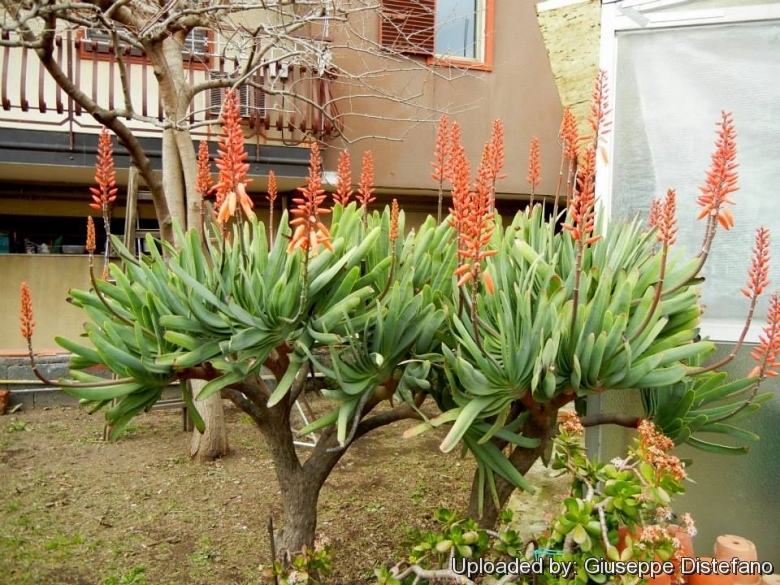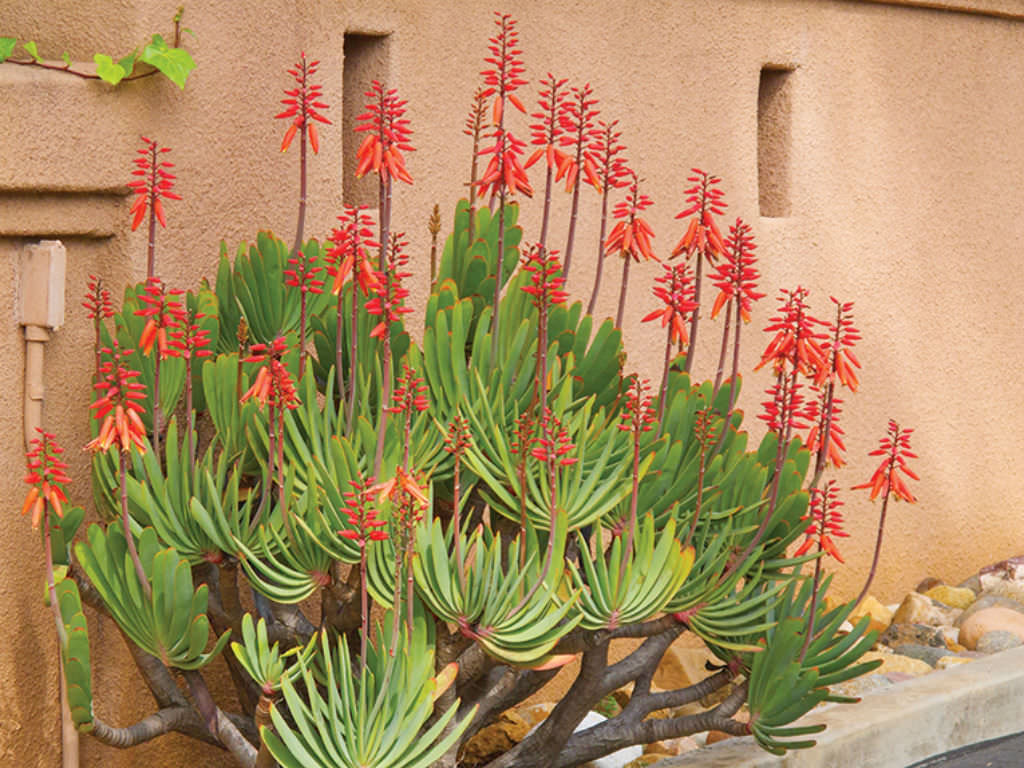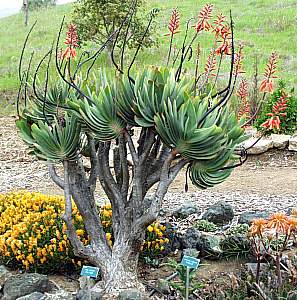This majestic Aloe tree stands tall and proud, its gray trunk splitting into numerous forked branches. Clusters of fan-shaped leaves, in a striking blue-green hue, adorn each branch, giving the plant its name. The leaves are oblong and pointed upwards. As the lower, older leaves wither and die, they drop from the branches, revealing more of the trunk. During Spring, the tree can be seen blooming red flowers.
Table of Contents
Care and Propagation Information
The Aloe plicatilis, or “Fan Aloe,” has fan-shaped leaves that give it its name. This type of Aloe is deer-resistant, making it a great option for gardens. Not only that, its flowers attract hummingbirds, adding to its appeal. Its fire-resistant trunk adds an extra layer of protection to xeriscaped landscapes.
Watering
The most appropriate way to water Aloe plicatilis “Fan Aloe” is to use the “soak and dry” technique and let the soil dry out completely between watering. During the Summer months, it’s best to give the plant only minimal amounts of water.
Where to Plant
If you live in an area with temperatures that drop below 20° F (-6.7° C), it is better to plant “Fan Aloe” in a pot that can be brought indoors and placed in front of a grow light during the winter. To ensure successful growth, be sure to place this succulent in a spot that gets at least six hours of sunlight each day.
Additional Information
It has been proposed that “Fan Aloe” (Aloe plicatilis) should no longer be placed in the Aloe genus, but instead be classified as a Kumara plicatilis, and added to the Aloiampelos tree Aloe genus.
How to Propagate Aloe plicatilis “Fan Aloe”
Cuttings
To propagate “Fan Aloe,” begin by using a clean and sharp knife or shears to cut a stem or branch from the main plant. Let the cutting sit for a few days to let it form a protective layer. Put the cutting in soil that drains well and keep the soil moist by checking to make sure it has dried out completely before watering.
Seeds
Aloe plicatilis, better known as “Fan Aloe,” can be grown from the seeds of its fruit, though this is not a preferred method of propagation due to the slow growth of this species. If you do choose to go this route, make sure you use a soil that drains well. Those living in a climate warmer than zone 9a can sow their seeds outdoors, while those in cooler areas should opt for starting indoors with a grow light or seed mat.
Care and Propagation Information
General Care for Aloe plicatilis “Fan Aloe”
The Aloe plicatilis, or “Fan Aloe,” has fan-shaped leaves that give it its name. This type of Aloe is deer-resistant, making it a great option for gardens. Not only that, its flowers attract hummingbirds, adding to its appeal. Its fire-resistant trunk adds an extra layer of protection to xeriscaped landscapes.
Watering
The most appropriate way to water Aloe plicatilis “Fan Aloe” is to use the “soak and dry” technique and let the soil dry out completely between watering. During the Summer months, it’s best to give the plant only minimal amounts of water.
Where to Plant
If you live in an area with temperatures that drop below 20° F (-6.7° C), it is better to plant “Fan Aloe” in a pot that can be brought indoors and placed in front of a grow light during the winter. To ensure successful growth, be sure to place this succulent in a spot that gets at least six hours of sunlight each day.
Additional Information
It has been proposed that “Fan Aloe” (Aloe plicatilis) should no longer be placed in the Aloe genus, but instead be classified as a Kumara plicatilis, and added to the Aloiampelos tree Aloe genus.
How to Propagate Aloe plicatilis “Fan Aloe”
Aloe plicatilis “Fan Aloe” can be propagated through either stem cuttings or seeds, though stem cuttings may be the most effective propagation method.
Cuttings
To propagate “Fan Aloe,” begin by using a clean and sharp knife or shears to cut a stem or branch from the main plant. Let the cutting sit for a few days to let it form a protective layer. Put the cutting in soil that drains well and keep the soil moist by checking to make sure it has dried out completely before watering.
Seeds
Aloe plicatilis, better known as “Fan Aloe,” can be grown from the seeds of its fruit, though this is not a preferred method of propagation due to the slow growth of this species. If you do choose to go this route, make sure you use a soil that drains well. Those living in a climate warmer than zone 9a can sow their seeds outdoors, while those in cooler areas should opt for starting indoors with a grow light or seed mat.
FAQ
Where does aloe Plicatilis come from?
Kumara plicatilis, which was formerly known as Aloe plicatilis, is a succulent plant with a fan-like leaf arrangement native to a few places in the Fynbos region of South Africa’s Western Cape. It can be a shrub or a small tree, and its appearance is quite distinct.
How do you propagate aloe Plicatilis?
Rewrite: To redo something in a different way.
How fast does aloe Plicatilis grow?
The growth rate of this plant is relatively slow, but not so slow as to be agonizing. It can typically add 10-20 centimeters of height to its stature yearly in ideal conditions. As this plant is long-lived, it can maintain its same position and soil for many years once it’s established.
Is Fan Aloe a succulent?
Kumara plicatilis, previously known as Aloe plicatilis, is a succulent that is native to a small number of mountains in the Fynbos ecoregion of the Western Cape in South Africa. Its most noteworthy characteristic is its fan-like arrangement of leaves, making it a particularly eye-catching species.
Is Aloe Plicatilis rare?
This Aloe is a rare and select variety that has been grown from seed. It is available in very limited quantities.



